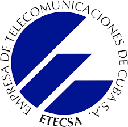Executive Secretary

21st International Symposium on Electrical Engineering
SIE 2025
Abstract
Abstract:
Problematic: The interpretation of the electrocardiogram (ECG) is essential in cardiovascular diagnosis, but its manual nature, especially in prolonged recordings, can lead to subjectivity and variability. There is a need for tools that systematize and expedite this process to optimize diagnostic efficiency. Additionally, many of the tools that offer these functionalities are restricted to assigned hardware and cannot be used as standalone solutions—an example being CardioTek's EP-Tracer, which has robust processing and visualization software but only operates in the physical presence of its hardware.
Objective(s): The objective of this study is to develop and implement a software system for loading, processing, and interactively visualizing ECG signals, with the capability to detect morphological features and calculate cardiac parameters.
Methodology: A theoretical investigation was conducted on the most commonly used and efficient methods and algorithms for processing and noise removal in ECGs. Subsequently, a desktop application was developed in Python, using Tkinter for the graphical interface and Matplotlib for data representation. Specific modules (*EP_method.py* and *MITBIH_method.py*) were implemented to load data from EPTracer binary formats and MIT-BIH records, respectively. Processing includes band-pass filtering (0.5–40 Hz) and notch filtering (60 Hz), followed by detection of P waves, QRS complexes (R peaks, Q and S points), and T waves (T ends), as well as the calculation of parameters such as heart rate, PR interval, QRS duration, QT interval, and QTc.
Results and Discussion: The system allows loading ECGs in the specified formats, providing interactive visualization with scale adjustments and navigation. It automatically plots detected points (P, Q, R, S, T) and displays a panel with the calculated cardiac parameters, updating when a heartbeat is clicked. This demonstrates the software's ability to assist in ECG signal analysis and interpretation.
Conclusions: A functional software system has been developed that meets the objectives of loading, processing, and visualizing ECG signals, offering a supportive tool for cardiovascular analysis.
Resumen
Resumen:
Problemática: La interpretación del electrocardiograma (ECG) es fundamental en el diagnóstico cardiovascular, pero su naturaleza manual, especialmente en registros prolongados, puede generar subjetividad y variabilidad. Existe una necesidad de herramientas que sistematicen y agilicen este proceso para optimizar la eficiencia diagnóstica, además muchas de las herramientas que ofrecen estas prestaciones vienen restringidas a un hardware asignado y no pueden ser usadas como herramienta individual ejemplo de esto el EP-Tracer de cardiotek el cual presenta un software robusto de procesamiento y visualización solo actúa en presencia física de su hardware.
Objetivo(s): El objetivo de este estudio es desarrollar e implementar un sistema de software para la carga, procesamiento y visualización interactiva de señales ECG, con capacidad para detectar características morfológicas y calcular parámetros cardíacos.
Metodología: Se desarrolló una investigación teórica de los métodos y algoritmos mas usados y eficientes en el procesamiento y eliminación de ruidos en los ECG y posteriormente se desarrolló una aplicación de escritorio en Python, utilizando tkinter para la interfaz gráfica y matplotlib para la representación de datos. Se implementaron módulos específicos (EP_method.py y MITBIH_method.py) para la carga de datos de formatos binarios EPTracer y registros MIT-BIH, respectivamente. El procesamiento incluye filtrado pasa-banda (0.5-40 Hz) y notch (60 Hz), seguido de la detección de ondas P, QRS (picos R, puntos Q y S) y T (finales T), y el cálculo de parámetros como frecuencia cardíaca, intervalos PR, QRS, QT y QTc.
Resultados y Discusión: El sistema permite la carga de ECG en los formatos especificados, una visualización interactiva con ajustes de escala y navegación. Grafica los puntos detectados automáticamente (P, Q, R, S, T) y presenta un panel con los parámetros cardíacos calculados, actualizándose al hacer clic en un latido. Esto demuestra la capacidad del software para asistir en el análisis y la interpretación de la señal.
Conclusiones: Se ha desarrollado un sistema de software funcional que satisface los objetivos de carga, procesamiento y visualización de señales ECG, ofreciendo una herramienta de apoyo para el análisis cardiovascular.
About The Speaker

René Jiménez

Discussion


 Bronze
Bronze